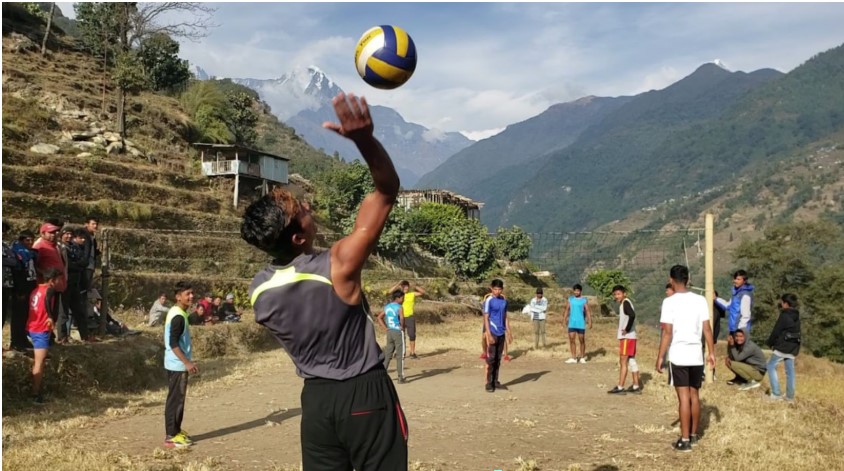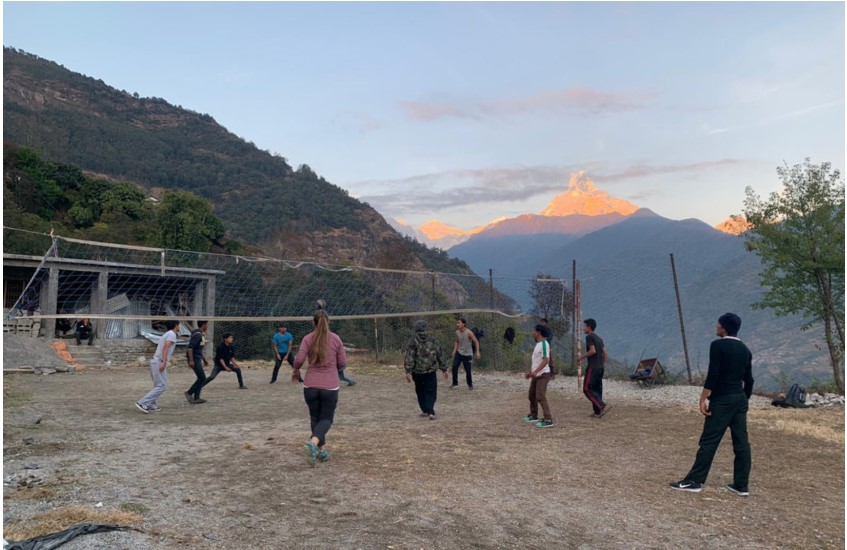LIFE IN THE HIMALAYAS: SPORTS & COMMUNITY
Guest post by Laura Shaw
Laura is a former high school teacher and coach from Canada who went to Nepal with Trek to Teach in 2019 and now volunteers with the organization to train future teachers.
In Nepal, volleyball is much more than just a game; it’s a community and a way of life. As you trek through the rural villages of the Annapurna Region in Nepal, you would be hard pressed not to come across a makeshift volleyball court or two somewhere along the way. Most of these courts have lines hand carved with a stick and the nets are often tangled messes of string, supported by wood posts hammered into the uneven ground. Some courts barely fit on the terraced fields, but are clearly spaces dedicated to the game. They might not look like much, yet with the backdrop of the Himalayas, these courts suggest there’s a lot more than just a game played here.

If you are lucky enough to walk by at just the right time, you will see locals arriving from all directions, converging at the court. There is no posted time, Facebook event, or text message invite; they just know when and where to show up. Life in Nepal is like that. Some of the boys walk straight from school in their uniforms, men arrive carrying doko baskets filled with grass for their buffalo, while others show up on pedal or motor bikes. However, they all have one thing in common: they’re from the same community. One of the regulars brings a ball or they stop in at the house next to the court where a family keeps their game ball safe. Once enough players have arrived, warmed up or not, it’s game on (after a few rupees are exchanged in a friendly bet, of course). Regardless of whether you think they look as though they’re about to play volleyball, considering the slip-on sandals, school uniforms, or blue jeans they’re wearing, rest assured that they’re always ready. Before you know it, the games are dominated by spin serves, diving saves in the dirt, and powerful hits. The expectations are high; a shanked pass, poor set, or hit out of bounds is generally followed by some bickering between teammates, all the while still calling each other “brother.“ The level of competition is likely far beyond what you would expect, but that’s only part of what makes the whole situation extraordinary.
From my perspective, volleyball has always been a sport played in a gym, with very specific rules, dimensions, and expectations. We have access to gyms with storage rooms full of equipment and play with shoes and gear specially made for volleyball. However, that’s not the case in rural Nepal. The locals learn to play on their makeshift courts, without knee pads or court shoes, carded officials or electronic scoreboards. As much as we might believe that those material items are part of the game, they really don’t mean a whole lot unless you have the skills to back it up. Most of the players in Nepal have better passing, hitting, and setting form than I do. They call positions by different names and have different passing rotations than I am used to. However, being able to play on an uneven surface instead of a gym floor, in shoes not meant for sport, on a net much higher than regulation, and outside at dusk or with the sun glaring in your eyes, creates a more competitive, resilient game; one that is void of excuses. In the end, the games still start at 0 and end at 25. But in Nepal, there isn’t a ref to blow the whistle signaling the end of the game, so they continue playing just for fun, until the sun goes down and they can no longer see the ball. They play until they can’t anymore because they truly love the game. For many, those games and that court are a commune, a brotherhood, and an escape, as sport has been for me so many times before as well.

When I eventually joined afternoon games at the community volleyball ground in my village, I was held to the same standards and expectations as the locals, despite the fact that I was the only female and non-Nepali person on the court. Even though I did not speak their language and understood the game in a different way, the purpose of the game remained the same. The game brought people together and perpetuated the greater sense of community that the Nepali people share. I felt accepted into part of their community and family because I shared the same love for the game as they did. All of a sudden, it became so much more than just a game. It’s a shared passion, way of life, learning opportunity, and meeting point place for a community. I was beyond grateful to find this in my home away from home, which has forever changed my vision of the game and life in Nepal. And so, I think if I ever had to choose where to play, I would pick the makeshift court overlooking terraced fields with a view of the Himalayas, every single time.

